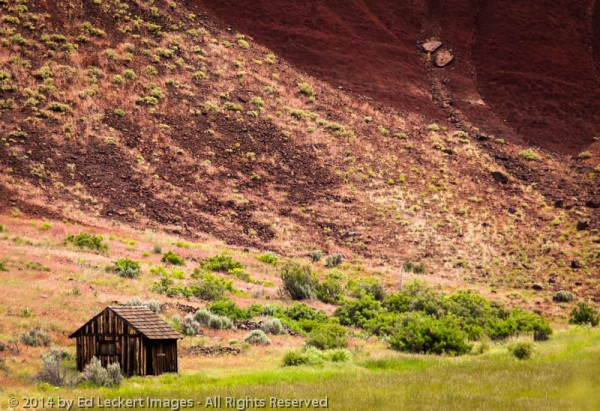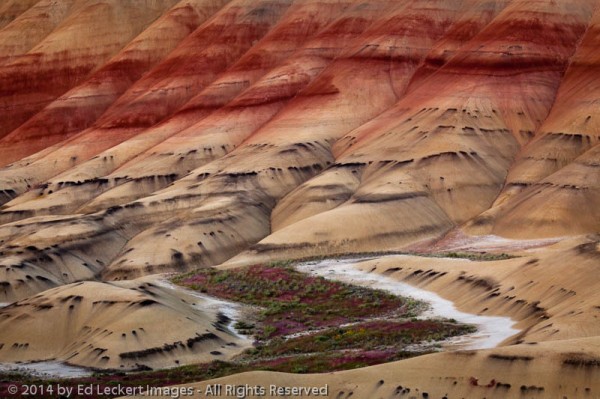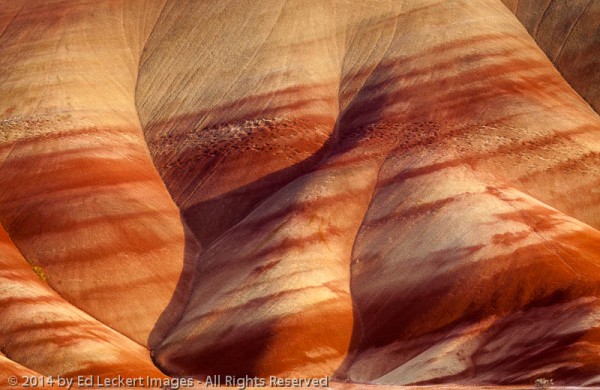


And red, and white, and black, and blue, and all kinds of colors! Of course I’m talking about one of Oregon’s Seven Wonders, the Painted Hills of the John Day Fossil Beds National Monument!
The John Day Fossil Beds National Monument is located in central Oregon in the John Day River valley. The river, the national monument, a dam, and two cities are all named after a hunter and trapper who wouldn’t have known a fossil if it had jumped up and bitten him in the keister. No, Mr. Day is most famous for being robbed and stripped naked by Indians on the Columbia River near the mouth of the river that now bears his name in Eastern Oregon. If that ever happens to me I hope they at least name the river after me.

A lonely shed sits below colorful cliffs at the Sheep Rock Unit of the John Day Fossil Beds National Monument, Oregon.
But even if he never found a fossil, the area protected by the national monument (which is technically named after the river, which in turn is named after the unlucky man) has been extremely instrumental in advancing the science of paleontology. While there are no dinosaur fossils here (because it was under the Pacific Ocean when Dino was running around), a huge diversity of life once roamed here, partly due to the way the area has changed over time. At one time a rain forest, the rise of the Cascade Mountain Range meant that species have had to adapt or move on as the climate gradually changed to now include semi-desert shrublands, riparian zones, and colorful badlands. Volcanic eruptions about 44 million years ago also made things interesting for the locals, and the resulting debris flows entombed plants and animals that we are now uncovering as fossils.

A lone tree stands guard between desert sagebrush and the Painted Hills, in John Day Fossil Beds National Monument, Oregon.
The first horses evolved in North America 50 million years ago, beginning with small, dog-sized animals that lived in the rain forest. They possessed several spread-out toes that enabled them to walk on the soft, moist grounds of primeval forests. Over time, as the climate dried and steppes began to appear, the horse’s predecessors needed to be capable of greater speeds to outrun predators. They achieved this through the lengthening of limbs and the lifting of some toes from the ground in such a way that the weight of the body was gradually placed on one of the longest toes, the third.

A dry bed of colorful soil and shrubs winds its way below the Painted Hills of the John Day Fossil Beds National Monument, Oregon.
As important and as fascinating as all this is, it is the colorful hills that draw photographers to the Painted Hills. The colorful layers of its hills corresponding to various geological eras, formed when the area was an ancient river floodplain. The black soil is lignite that was vegetative matter that grew along the floodplain. The grey coloring is mudstone, siltstone, and shale. The red coloring is laterite soil that formed by floodplain deposits when the area was warm and humid. Laterite is rich in iron and aluminium, and nearly all laterites are rusty-red because of iron oxides.

The Painted Hills of John Day Fossil Beds National Monument, Oregon, glow in the late afternoon sun.
Well, that’s enough education for one sitting. While the John Day Fossil Beds National Monument takes a bit of effort to get to, it is well worth the trip for the sheer beauty of the area if for no other reason. So if you ever find yourself anywhere near central Oregon, take the time to check this place out. You’ll be glad you did!

VERY beautiful, Ed! I can’t wait to see these hanging in your booth.